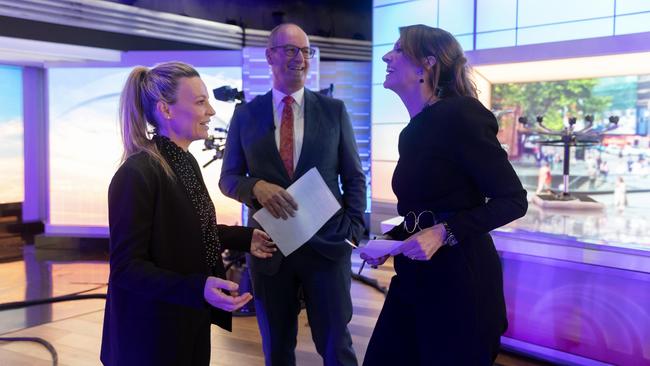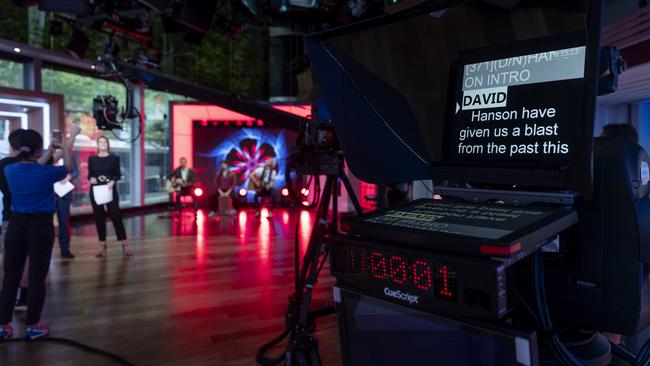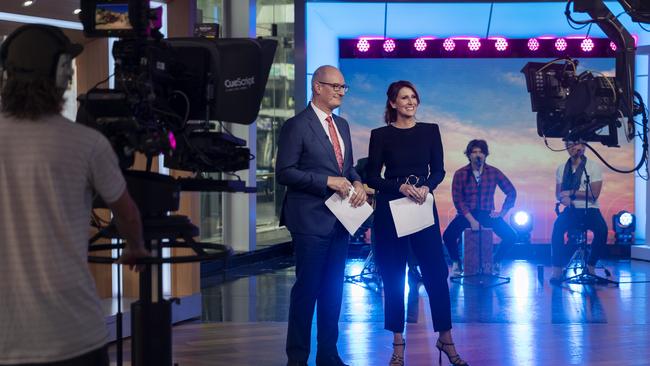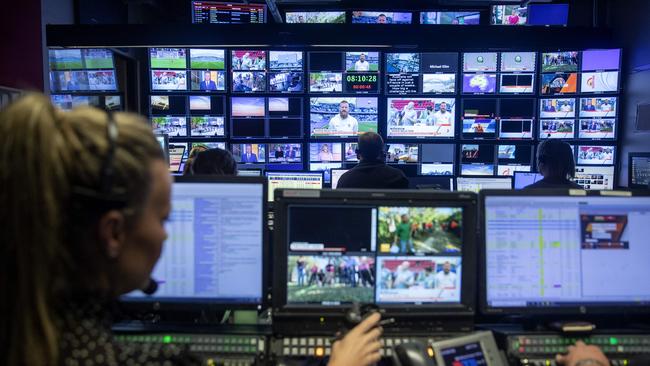Inside the hyper-competitive world of breakfast TV
Sunrise boss Sarah Stinson has the biggest job in morning television. Can she keep the ratings juggernaut at the top while reimagining it for the social media generation?

It is Wednesday morning and pop band Hanson – known for their 1997 hit MMMBop – is performing in the Seven Network studio at Martin Place in Sydney.
Despite some 25 years since it topped the ARIA charts, the band has drawn a crowd. Craig David, who had appeared on Sunrise one day earlier, had not managed to attract these numbers.
David Koch and Natalie Barr, the two Sunrise hosts, will have 15 seconds to introduce the Hanson brothers, before a 58-second pre-prepared package rolls. The performance will take four minutes, according to a 38-page run down that documents every segment of the breakfast show down to a tee.
Next, Koch and Barr are interviewing Ryan Churches, a fisherman from New Zealand who had been piloting a boat when a 150kg Mako shark jumped on board.
In the control room, a crew is counting down the timer. In the back sits Sarah Stinson, who has several calls to make. Virginia Giuffre, a sex trafficking victim of Jeffrey Epstein, is not proceeding with a claim against prominent lawyer Alan Dershowitz. Someone will have to cover the story.
And the Hanson performance has been a hit. The crowd is pressing against the glass, and Stinson – the newish director of morning television at Seven – wants more. A camera and reporter are going outside to speak to the fans.
Maybe one of them could even come into the studio during the next program, Mornings, which Stinson also oversees. We could grant one Hanson super fan their dream, she is telling Sean Power, Sunrise’s executive producer. “I’ll just check she’s not on any watch list,” Power says.

In 1998, unready to commit to any particular career, Stinson went to London. As she tells it, she found herself running on a treadmill beside a businessman with a distinct Australian accent and they struck up a conversation. He offered to help find her a job in television – where he said he had contacts – if she so desired.
That businessman, it turned out, was Bruce Gyngell – one of the most powerful television executives in the country. He made the introductions, in a letter urging Stinson to “accept ANY position”, and a job was secured.
“I can remember, it’s so visceral, every single thing about that day,” Stinson says in an interview about her first day at the Nine Network studios.
“I remember the colour green, I remember the dressing rooms, I loved that everyone was swearing and smoking. It felt rebellious, it was titillating, it was exciting and for the first time in my life I went, ‘this, I love it’,” she says.
“It was only meant to be for a month, but I worked out pretty quickly that ‘OK, I’m going to have to keep on making up jobs’ otherwise they’ll get rid of me.
“I was in the newsroom sitting next to (long-serving Nine correspondent) Peter Harvey, so I’d get his lunch each day, then I learnt to roll the autocue … then I would go and get the editors their cigarettes running up and down the hill to the shops until a production assistant role came up, and I think everyone looked at me and felt sorry for me,” she says.
An internship became a production role on Today, the other side of the great breakfast TV rivalry with Sunrise, and later time on A Current Affair.

“You haven’t lived life until you’re driving around looking for the first run of a newspaper, then quickly flicking through, working out the story of the day and thinking ‘f … this is it’, jumping in my little Nissan Pulsar with the Gregory’s (street directory) and trying to chase a story,” Stinson says. “Being young and exposed to that level of competition, and the ratings, well you lived or died by them because it would dictate the mood of the boss.”
Then it was a jump to Today Tonight at Seven, where Stinson quickly became the chief of staff before the network handed her the reins of The Morning Show in 2010. In April this year, she was appointed director of morning television, a position which covers Sunrise and Mornings.
Breakfast TV is about as competitive as it gets in the industry, and Sunrise has long dominated the ratings. Michael Pell, the last executive producer of Sunrise, is in Los Angeles as Seven’s senior vice-president of entertainment content in North America. Some at Seven privately wonder what exactly that role entails.
Pell kept Sunrise a ratings machine as executive producer, a position he held from 2010 to this year, when he left for California.
Before Pell came Adam Boland, who like Stinson was the director of morning television. He suffered a major breakdown in the role in 2007 and subsequently left to help Network Ten launch its own breakfast show, the poorly-received Wake Up.
Breakfast TV can also be a difficult world of extra-large personalities. There were the long-running rumours that Pell and a former Sunrise presenter, Samantha Armytage, had had a major falling out before Armytage left the show in 2021. (Pell has subsequently denied a rift, and described their relationship as “like a brother and sister”.)

Shortly after Stinson took the top job, The Sunday Telegraph’s Confidential column published a blind item laying into the ratings, claiming in July that network executives were hoping that the Commonwealth Games would boost ratings and that there was “one timeslot they especially want to prop up – the network’s breakfast show Sunrise”.
The show was “struggling in the all-important east coast markets: and numbers were the worst they had been in two decades.
It was curious criticism of a program that had not lost a single week to Today this year.
Craig McPherson, the networks’ longstanding news and public affairs director, is one of Stinson’s biggest supporters, describing herself as “a very industrious, driven person who is very selfless in her approach”.
“The show is doing very, very well,” McPherson says. “Part of what Sarah has done since she’s come in is create more synergies with the sales team, and we are squeezing more out of the lemon in that area. Dollar in, dollar out, it is one of the most profitable shows on television and it is one of the most important,” he says.
Sunrise “needed rejuvenation and a burst of freshness and energy,” he adds. “The battle between Sunrise and Today is no different to what it was yesterday, last month, two years ago. It is a real fight for the audience.”
But the changing nature of TV viewing – the rise of streaming services and video-on-demand – has changed the industry forever. The Australian in May reported official OzTAM data stretching back to 2012 showed both Today and Sunrise had lost a large part of their audience in a decade.
In 2021, the average weekday metro audience of Sunrise was 260,650, down 28 per cent from a decade earlier. On Today, its average audience was 219,032, a 35 per cent drop since 2011.
Stinson says she has “a weight of responsibility not only to keep two shows that have been number one for an incredibly long time at number one,” but to make decisions that create a workable environment in the studio. “I want to retain the best possible staff, I want to be attracting the best staff and we have seen people who have left previously willing to come back,” Stinson says.

As for the ratings? “Obviously we look at our broadcast ratings, but now we are broadcast and digital. We are social media. So we have more available audience than ever before,” she adds.
Sunrise is now on TikTok, the wildly popular social media platform that has largely taken over from Facebook and Instagram as the place for brands to be.
McPherson says the realities of social media have meant some changes to what is broadcast. “It has to be more catchy, more vibrant and entertaining,” he says.
The Hanson super fan passes vetting and is brought into to meet the band. Sunrise drew 224,000 metro viewers that Wednesday, according to OzTAM data, while Today managed 178,000. ABC Breakfast had 160,000 viewers.
“It’s just instinct,” Stinson says about her last minute decision to keep Hanson on air for longer.
“I always make television that I want to watch and thinking of the headline,” she adds. “In this role, we make so many decisions a day and make them so quickly, so then I have to sit down and work out why I made it.”
“I play each day like I’ve lost the day before.”

To join the conversation, please log in. Don't have an account? Register
Join the conversation, you are commenting as Logout